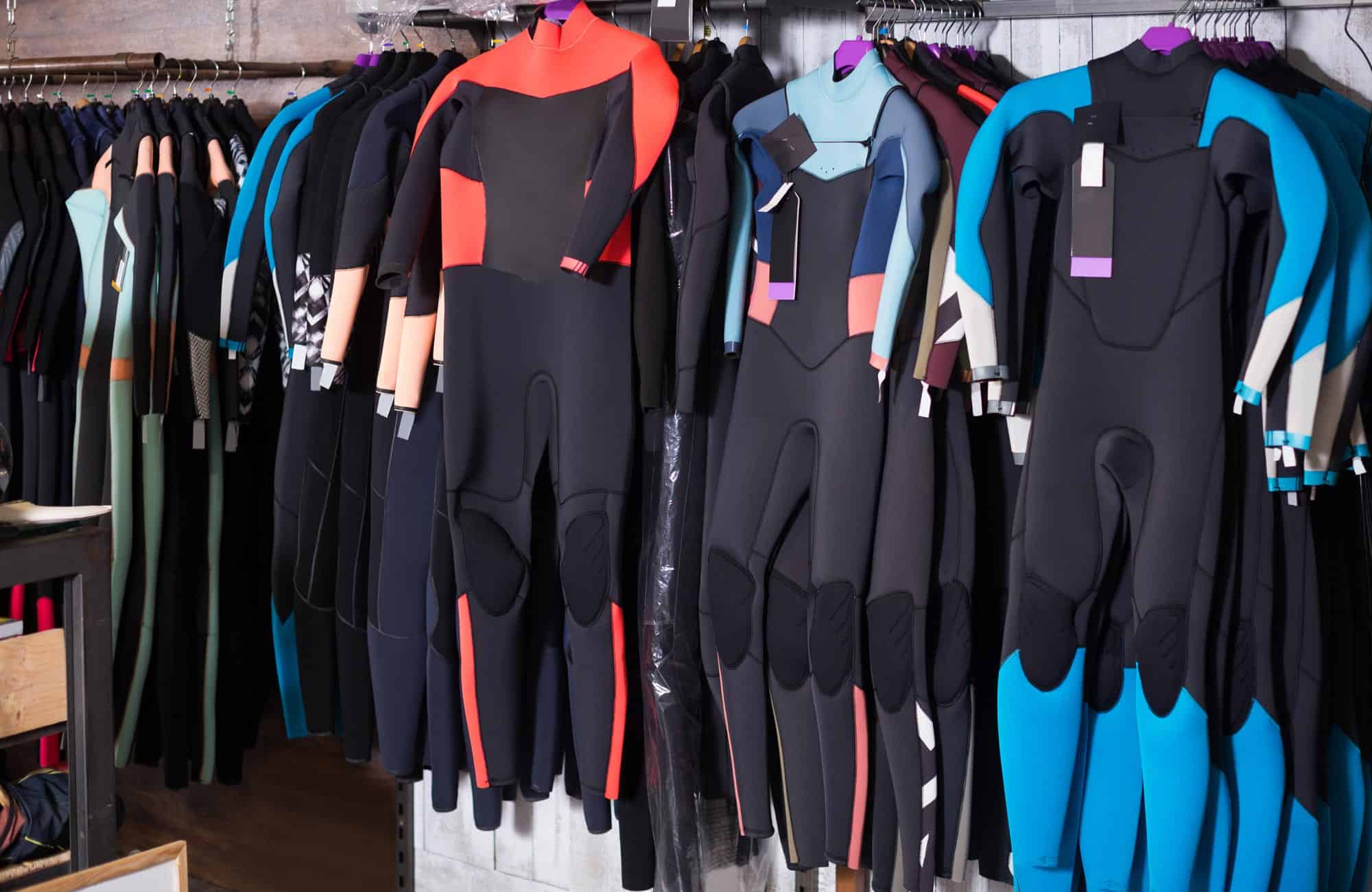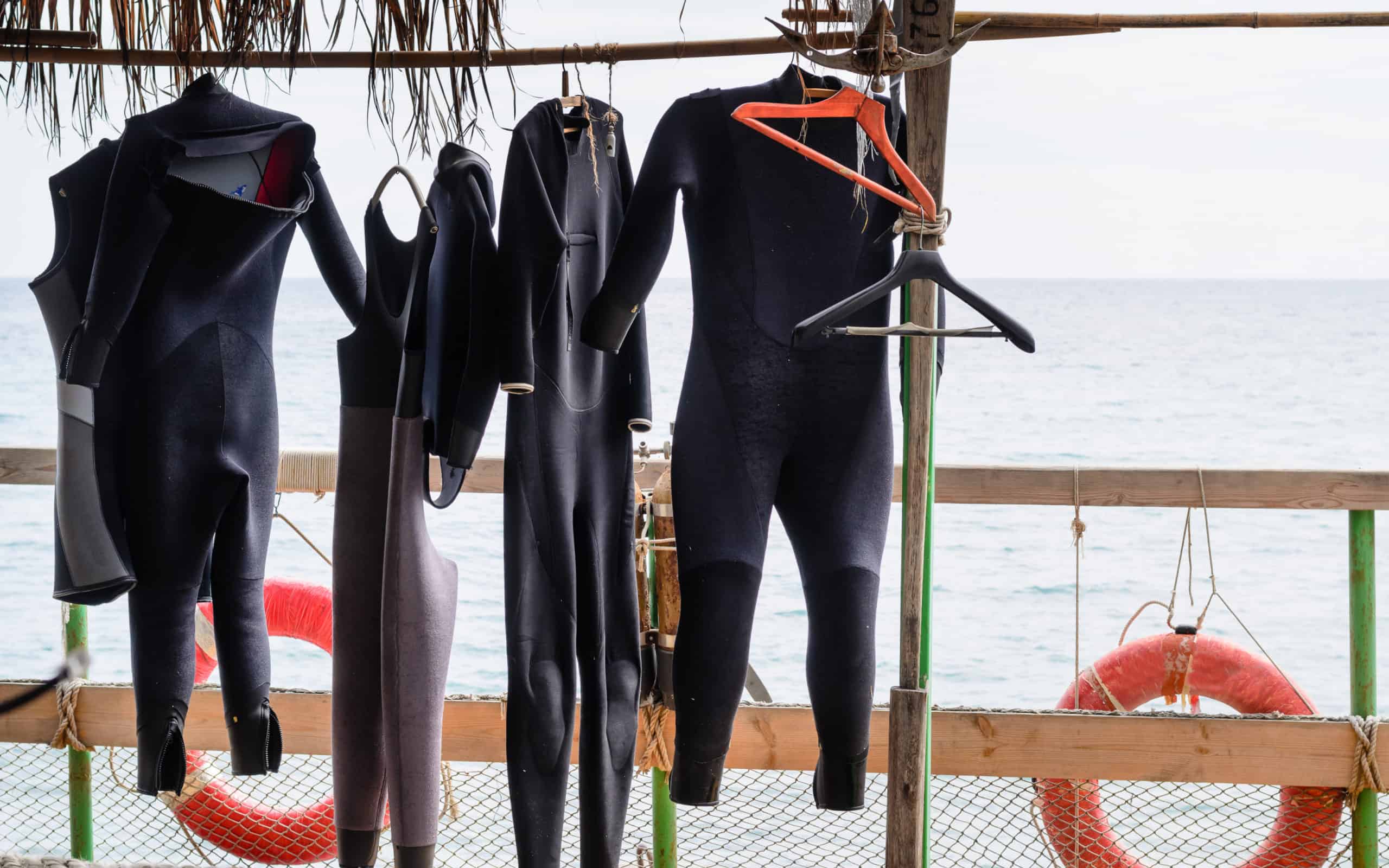Thanks to the invention of wetsuits, surfers can go in the water any time of the year, whether it’s summer, fall, winter or spring. A wetsuit will keep the body warm in the water while absorbing perspiration at the same time. Wetsuits are made primarily from neoprene, which is a synthetic rubber that is the product of chloroprene. Like any other article of clothing, a wetsuit needs to be washed from time to time to keep it clean.
Can you put a wetsuit in a washing machine? It is not advised that you wash your wetsuit in a washing machine. You should not put your wetsuit in a dryer, either, under any circumstances. Keep your wetsuit away from heat at all times. Heat is the enemy of neoprene.
You should wash your wetsuit only with cold water. Rinsing it after you surf will help keep it clean. Never use bleach, detergent, oils, or any other cleaning product except for mild shampoo (like baby shampoo) or liquid soap.
How Do I Wash A Wetsuit?
Like any other article of clothing, you should keep your wetsuit clean and dry to make it retain its shape and functionality and to make it last a long time.
- Rinse off your wetsuit after each surfing session. There is likely to be sand, some seaweed, and grime on the suit. When you take it off, it will be inside out, but that’s okay: rinse the inside of the wetsuit, then rinse the outside. Rinse both sides thoroughly.
- Only use cold or lukewarm water when rinsing your wetsuit! Heat is unbelievably bad for neoprene wetsuits. Heat causes the suit to break down and become less functional over time.
- Don’t ever leave your wetsuit in the sun or your car on a hot day. The heat from any source, whether it’s water or the UV rays of the sun, is the enemy of a wetsuit. The heat will cause the fabric to deteriorate so it won’t do its job after some time.
- After you’ve rinsed the wetsuit, hang it up to dry on a hanger, but not a traditional one. A hanger that allows you to slide the suit onto it is the best. If you don’t have a sliding hanger, do not use a regular hanger because it will ruin the shoulders of the wetsuit. If need be, you can hang the suit over a door inside out.
- Dry the wetsuit inside out before turning it around and drying right side out. The direr is on the inside, the faster it will dry on the outside.
- If there is an odor to your wetsuit, rinse it in fresh, warm water in the tub. There are wetsuit soaps you can buy specifically to rid the suit of odors. Otherwise, you can rub it with baby shampoo by hand. When you’ve finished, rinse it thoroughly to make sure all the shampoo is removed, then dry it on a suitable hanger in the fresh air.
- These steps should be taken no matter if it is a full body wetsuit, or a wetsuit jacket or vest. Remember to unzip the wetsuit zippers before washing.
- The best area to clean a wetsuit is a tub or a deep sink.
- After the suit is completely dry, lay it flat until you sue if again. Keep it on the hanger.
NOTE: If you don’t have a slide hanger, you can use a regular hanger that is THICK. If you don’t have a thick hanger, get some duct tape or gorilla tape, and wrap it around the ends of the hanger to make it thick.
If you use a typical wire or plastic hanger, you will ruin the shoulders of the wetsuit.

How Does A Wetsuit Keep Me Warm And Dry?
When you go out during a cool fall day or in the cold of winter, you wear clothing in layers. You might wear an undershirt or t-shirt, then a regular button shirt over the t-shirt, followed by a sweater over the regular shirt. Last, you wear a thick jacket or coat over all the layers underneath.
What if you wore instead an undershirt and then a very thick coat over the undershirt? Would this method of dressing keep you as warm as the layered approach, even if the coat were very thick? Odds are that the layered clothing keeps you warmer longer than just wearing a t-shirt and a tick coat.
Thin layers trap warm air in between the layers. The warm air between layers is what keeps you warm. The more layers, the warmer you are. This is similar to the way a wetsuit keeps you warm.
Heat flows from hotter objects to colder ones. In the cold outside, heat flows out from your body into the cold air and this heat transfer causes your body to cool very rapidly. But when you put on layers of clothing (or a wetsuit), the heat wants to transfer out into the air (or into the cold water), but it takes much longer because the heat has to flow out through each layer and will get trapped in between. These air spaces between layers are called airlocks.
Stopping heat from escaping in this manner is a way of insulating your body from the cold. Insulation means stopping heat from escaping.
When you wear a wetsuit, you are insulating your body from the cold water using layers as airlocks that trap the heat inside. Wetsuits are made from multiple layers of neoprene and come in different thicknesses.
Neoprene is synthetic and is much like a foam rubber. The neoprene rubber has nitrogen gas bubbles trapped in it, which increases its ability to insulate the body.
The moment you step into the cold ocean water wearing a wetsuit, a tiny amount of water seeps into the suit between the neoprene and your skin. It remains there the whole time you wear a suit.
The heat from the body warms this small amount of water until it’s at or near your body’s temperature.
The layers you have in the wetsuit are first, the neoprene rubber, then warm water, and finally, multiple layers of insulation.
Starting from your skin and going out to the water in contact with the suit, this is how the body is insulated from the cold.
- Skin
- Warm water that seeped through the suit that is warmed by your body.
- A sewn-in fabric that acts as a barrier between your body and the chafing neoprene rubber, made either of nylon or another comfortable synthetic fabric.
- Heat reflecting material comprised of metal like titanium, silver, aluminum, or copper.
- A thick, durable outer layer that is both water and abrasion-resistant.
What Happens If Cold Water Gets Through The Wetsuit?
The main reason that you’re not fully protected in a wetsuit is that it isn’t fitted properly. A suit that is too loose anywhere and doesn’t cling to the body will allow too much water to seep through, resulting in the water puddling in the loose areas.
You must make sure that water doesn’t flush in and out o the suit. The wetsuit has seams, where separate panels of neoprene join together and are sealed with waterproof tape.
Wetsuits are also stitched in such a way that they go only partly through the neoprene form the inside. This means that there will be no stitch holes in the wet suit that would allow water to seep through.
How Do I Find The Right Size Wetsuit?
When you buy a business suit, there are different measurements to keep in mind, like the chest size (or bust size for women), your height, weight, hip, and waist measurements. There are the same considerations when buying a wetsuit.
There are 5 sizes that wetsuits come in
XS: Extra Small
S: Small
M: Medium
MT: Medium Tall
T: Tall
X: Extra Tall
Sizes go even higher, but these are the most popular sizes worn.
Height, weight, chest, and waist are the four categories that you sue to match up to get the best size for your body.
Related Questions
What If I Am Tall But Thin?
You would look in the extra tall category. The wetsuit chart factors in your height and weight s well as your waist and chest size.
So if you are 6 feet two inches, but weigh just 160 pounds, and your chest is 40 inches and your waist is 31 inches, you would get a suit that is in the “MT” range.
Always ask a surfing specialist for help reading the wetsuit fitting chart.
How Are Wetsuits Fitted For Women?
Wetsuit size estimations are different for women. The 4 main factors are height, bust, hips and waist sizes.
How Often Should I Rinse My Wetsuit?
You should rinse your wetsuit each time after you come out of the water. It is important to keep grime and sand as well as seaweed particles off the wetsuit so that the neoprene doesn’t break down prematurely.
The more you clean your wetsuit, the longer it will last and protect you better in cold water temperatures.

